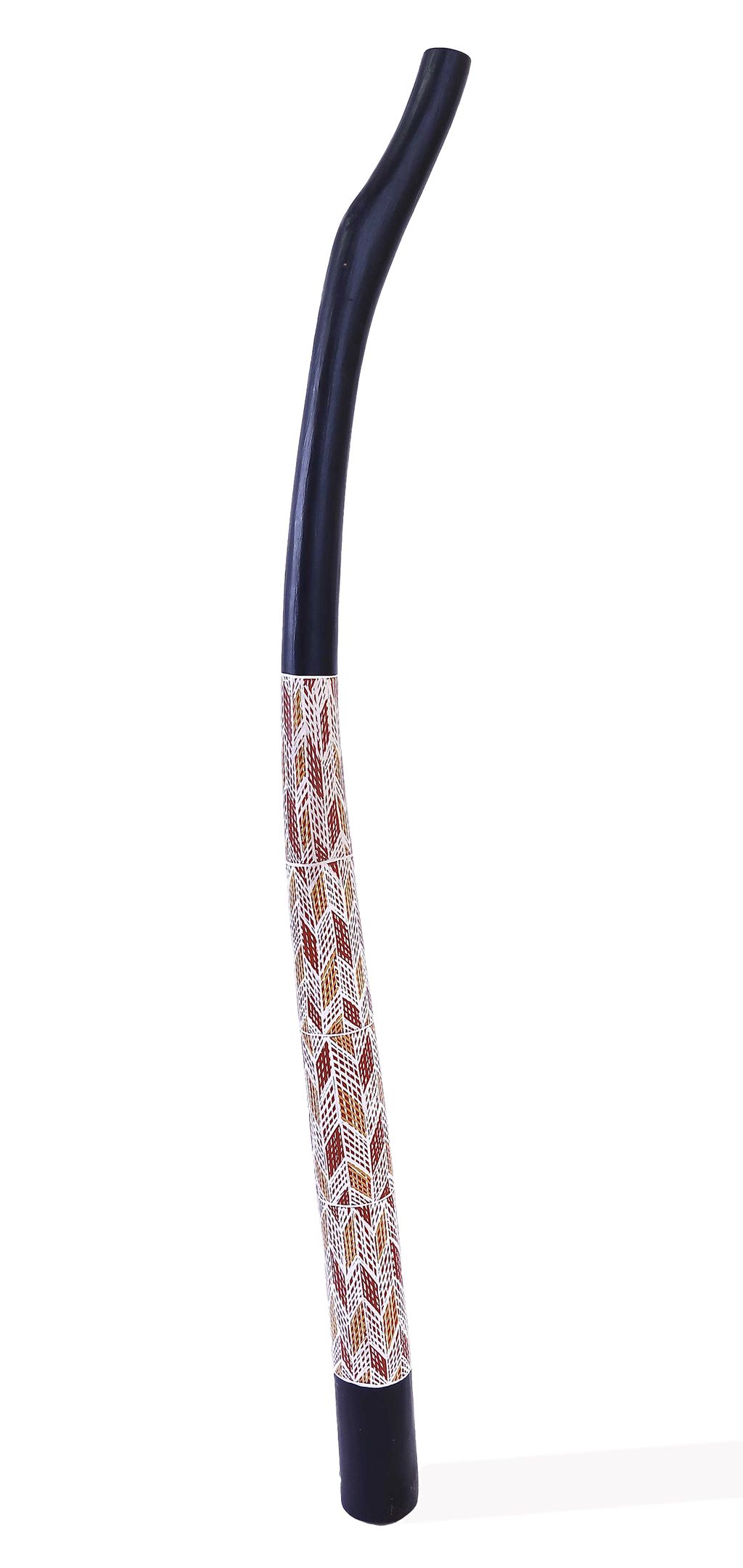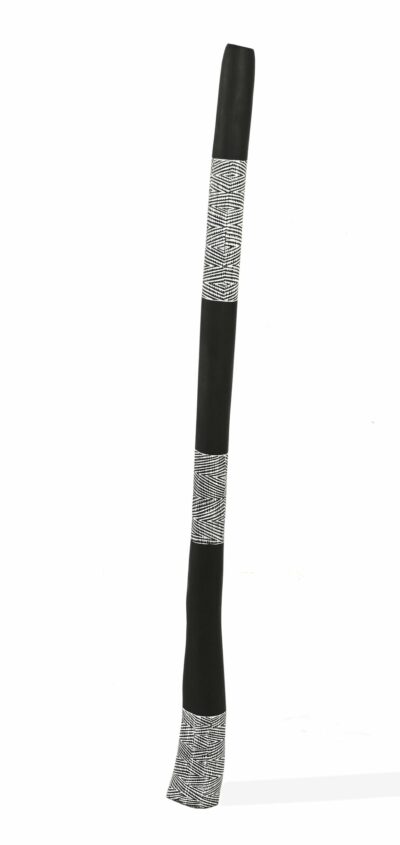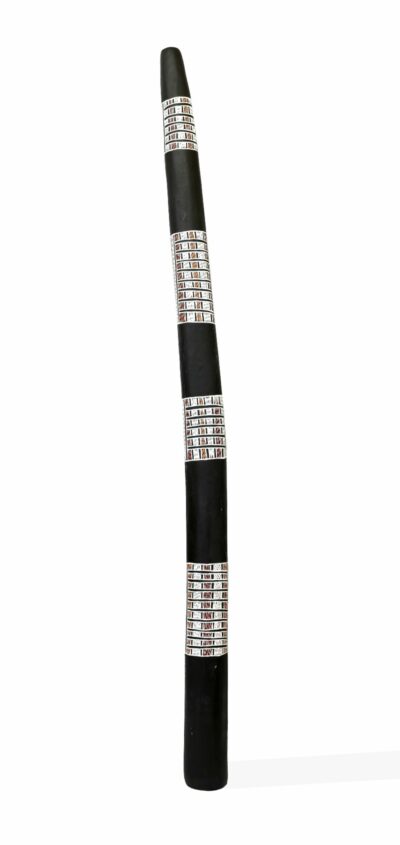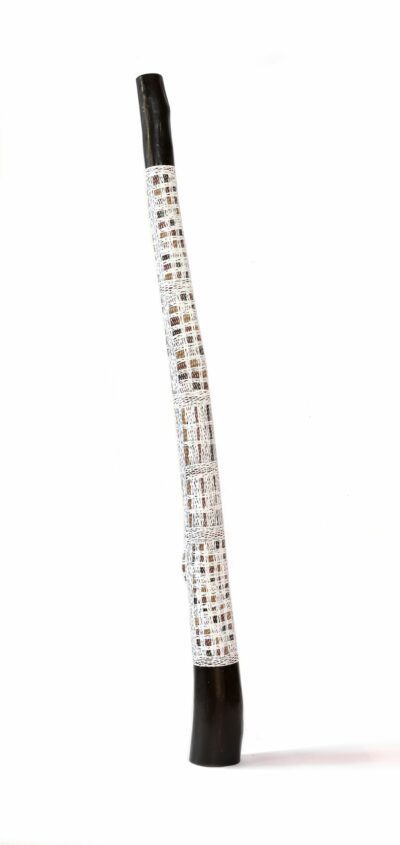Description
marikuku wirrpanda
Earth pigments on Stringybark hollow pole
137 x 8 cm
Year: 2024
ID: 563-24
Yiḏaki
Yiḏaki are didjeridus that are specific to North East Arnhem land in Australia’s Northern Territory, where the instrument originates. The term yiḏaki is used in Yolŋu (the nation of North East Arnhem land Aboriginal people) languages as the generic name for the didjeridu. The name yiḏaki is most correctly used for instruments from this region that have been solely made and decorated by Yolŋu people.
Yiḏaki were originally limited to the Northern extremes of Australia, in particular Arnhem land. In relatively recent years, yiḏaki spread to other parts of Australia and the rest of the world. Yiḏaki began to be manufactured in different ways and with different types of materials. It became commonly known as the didjeridu, a non-Aboriginal term for the instrument. Through it’s International popularisation as the didjeridu, it has been somewhat displaced from it’s spiritual and cultural roots that are still held by the Yolŋu in Arnhem land today. The Yolŋu are masters of making and playing the yiḏaki and are well known Internationally for their quality instruments and complex yiḏaki playing styles.
Yolŋu artists carefully select naturally occurring termite hollowed tree stems, which are cut and shaped into suitable sounding instruments. They are made with certain desired acoustics that can vary dramatically between different clans, from high pitch to very low. Typical yiḏaki have small natural wooden mouthpieces around 30mm in diameter and taper out to a diameter of around 100mm at the distal end. Having a small mouthpiece means they require less air to play and produce sound easily as a result.
The vast majority of yiḏaki are made from Gadayka (Stringybark – Eucalyptus Tetrodonta). Gadayka is by far the most common tree in the North East Arnhem land region and often grows in a conical shape, which is desired for acoustic reasons. Occasionally, Guŋurru ( Woolybutt – Eucalyptus Miniata) is used.
In appearance yiḏaki seem to be a simple instrument, however the playing styles of the Yolŋu are complex and require many years of practice. Yiḏaki are played by vibrating the lips which produces a basic tone. This tone is maintained continually using cyclic breathing and is varied through use of the playing pressure, the tension in the cheeks, the use of the diaphragm, the tongue position and the use of the voice.
Traditionally, yiḏaki are painted with naturally occurring red, white, black and yellow earth pigments. In recent years acrylic paints began to be used. Both the artwork and the sound and overall style of the yiḏaki denote cultural history and law.
This particular yiḏaki has been painted with Earth pigments with a Dhudi-Djapu clan design that references the following story.
The ancestral shark with the generic name of Mäna traveled country belonging to various Dhuwa clans who share ritual song of his journey. His travels started in Dhuwa country for the Djambarrpuyŋu where he lived at Gurala. A Yirritja ancestor called Murriyana and his wives came to hunt at this place. The women went out collecting oysters and saw the shark with the special name of Dhakamawuy. The hunter Murriyana speared the shark, wounding him. Mäna left the country to travel an epic journey which is sung and at times re-enacted by Dhuwa clan participants in ceremony.
He traveled, as great creator ancestors do, under ground to surface through water at various points of significance in North East Arnhem land. At one such place in Yirritja land near Gångan he “heard the water coming through.” Mäna decided to leave this place and water for his waku (important kin relationship to the opposite moiety through a close female) and he re-emerged not so far away at a place named Wandawuy #1, where he hit his head on a rock that marks this spot today. This is spoken of as Mäna transferring some power to the rock hence this place. Mäna moved on, to many other places including the islands of Groote and surrounds.
His resting place however, is this area of freshwater belonging to the Dhudi-Djapu clan. The waters of the great Wayawu river that usually are spoken of with a Maŋgalili/Yirritja clan reference ran into this place Rinydjalŋu, so then the shark, imbuing ownership to the Dhuwa. This is made clear by understanding that the sacred clan design woven into this represents the power of Gunduyŋuru in the freshwater belonging to the Dhudi Djapu clan.
In this lower reach of the Wayawu river, the water banks up into massive billabongs of which Rinydjalŋu is part. Feeling the need to rest, settle and populate, the shark swam through a special thicket of water palm that ceased his travels. This plant is sung as darraŋgi and this design is based upon this plant.






Reviews
There are no reviews yet.